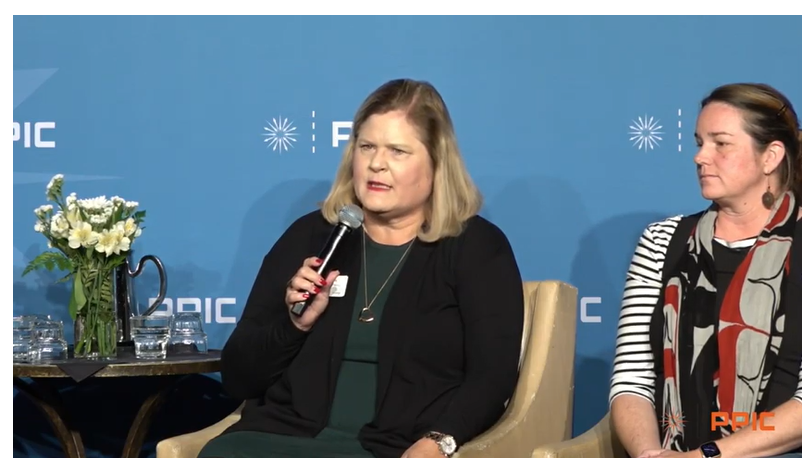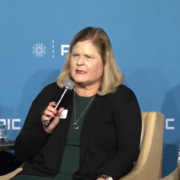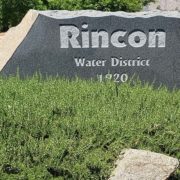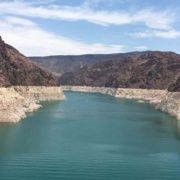PPIC Video: Surplus and Shortage — California’s Water Balancing Act
After three years of virtual events, the PPIC Water Policy Center’s annual fall conference made a welcome return to an in-person format in Sacramento on Friday, November 18. The half-day event began with a welcome from PPIC Water Policy Center assistant director Caity Peterson and a presentation by senior fellow Jeffrey Mount.
This year was “brutal” for agriculture, said Thad Bettner of the Glenn-Colusa Irrigation District during the first panel, moderated by PPIC Water senior fellow Alvar Escriva-Bou. “We took about 300 square miles out of production.” The drought hit rural and urban communities hard, too: Kyle Jones of the Community Water Center said that “over 1,300 [drinking water] wells went dry.” Bill Hasencamp of Metropolitan Water District described in vivid detail how once-reliable water management strategies are failing, in part due to a lack of interconnections: his agency had to restrict deliveries to “one-third of our service area despite having a record amount of dry-year storage reserves.”
Drought and climate change
The environment suffered as well, though Sandi Matsumoto of The Nature Conservancy praised the State Water Board, River Partners, and others for efforts to aid wildlife. Well-timed curtailments in some basins, she said, were helpful. But the stakes are high, she said: “Over half of California’s salmon and steelhead species are on a trajectory towards extinction.” And as Hasencamp put it, “drought and climate change have outstripped us.”

Sandra Kerl commended Scripps Institution of Oceanography for their “game-changing” atmospheric river forecasts—and panelists highlighted the promise of Forecast-Informed Reservoir Operations (FIRO) as a tool to make the most of storage infrastructure. Photo: Screenshot from PPIC Water Policy Center annual fall conference Nov. 18.
Reservoir storage capacity
Capturing more water during wet periods will help California weather the dry periods, said participants in the second panel, moderated by research fellow Andrew Ayres. Sandy Kerl of the San Diego County Water Authority said that investing in reservoir capacity was key after the county suffered a crippling drought in the late ‘80s. “We now have enough storage capacity…to sustain the population at a 75% service level for six months,” she said.
Socking water away in underground water banks is another important strategy, said Mike Tognolini of EBMUD. Such projects rely on good relationships. After some early missteps in a water banking pilot project, he said “we [now] have solid partnerships with local water agencies in San Joaquin County and, importantly…with growers in the region.”
Groundwater recharge and water banking
Aaron Fukuda of the Tulare Irrigation District emphasized the importance of trust-building too. “I tell everybody when you want to strike up a partnership, just take them out to dinner,” he said, to laughter. Groundwater recharge works best when relationships are formed first, and how you approach water right holders matters, he said. “When you ask a farmer for help, they will help.”
Kerl commended Scripps Institution of Oceanography for their “game-changing” atmospheric river forecasts—and panelists highlighted the promise of Forecast-Informed Reservoir Operations (FIRO) as a tool to make the most of storage infrastructure. Local agencies are also making good progress in accounting for water once it’s in the ground—key to facilitating more water banking projects.
And, as Julie Rentner of River Partners noted, the stakes for managing the increasingly flood-prone wet periods of our changing climate could not be higher. In 1997, the San Joaquin Valley was hit by a flood that broke the valley’s flood control system in 17 places. Climate projections show that a flood three to five times that magnitude “will likely hit the San Joaquin Valley in our lifetimes.” The damage, she said, would be incalculable. But California’s “new Central Valley flood-protection plan…takes a solid look at multi-benefit projects” that slow floods, recharge groundwater, and support habitat restoration.
‘Climate whiplash’
The day’s final panel looked at policy’s role in responding to climate conditions. PPIC Water Policy Center director Ellen Hanak sat down with California Department of Water Resources director Karla Nemeth, State Water Board chair E. Joaquín Esquivel, and US Army Civil Works Program assistant secretary Mike Connor. Hanak asked these policy heavy-hitters to share progress and gaps in “this moment of climate whiplash.”
“We’re now in a moment where it’s like ‘Everything, Everywhere, All at Once,’” said Karla Nemeth. “We’re in a multiverse….everything is moving.” Hotter temperatures have now become “their own water demand,” she said, and Californians need to embrace water recycling, desalination, recharge, and conservation—all while keeping water affordable. But California also needs to think big, she said. “We can’t be afraid of taking out big infrastructure or putting in big infrastructure.” As an example of the former, she noted progress on removal of the dams on the Klamath River. And for the latter, she noted that “the Delta conveyance project is enormously important to climate adaptation.”
Hydrology and resilience
Esquivel said that water projects that were state-of-the-art 50 years ago now find themselves “mismatched for the climate that we have.” While data has improved, “data alone is not enough. It has to turn into better decision making.” A “greater fidelity to reality,” he said, will be essential. He said compliance across multiple basins with water right curtailments is heartening. “People want to use rights in ways that help support the resilience of us all.”
Mike Connor shared that much of the country still struggles to understand how profoundly conditions have changed. In one eight-week period this summer, he said, “there were six one-in-one-thousand-year precipitation events across the continental US.” He said that “restoring hydrologic function wherever we can…always adds to water availability by keeping it in the system.” All panelists agreed that increased funding, including from the recently passed Inflation Reduction Act, will be a boon to efforts.
We invite you to watch the videos from this event:
- Welcome and introduction by Caitlin Peterson and Jeffrey Mount
- Shortage: Strategies for Dry Years
- Surplus: Strategies for Wet Years
- Finding Balance: Policy’s Role in Adapting to Extremes
(Editor’s Note: Permission to republish blog post granted by PPIC Water Policy Center)







 Sweetwater Authority Logo 2019
Sweetwater Authority Logo 2019

